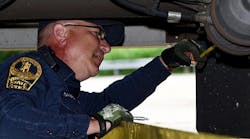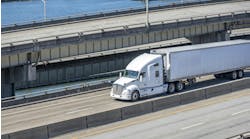This Sept. 15-21 the Commercial Vehicle Safety Alliance (CVSA) will hold its annual Brake Safety Week. U.S. and Canadian commercial vehicle inspectors will pay special attention to braking systems, hoses, tubes, automatic adjustment mechanisms and malfunction indicator lights.
As with other CVSA enforcement events, Brake Safety Week may have law enforcement stopping and inspecting vehicles from fleets which have otherwise qualified for electronic bypass programs.
On May 15 this year CVSA conducted an unannounced brake inspection blitz. More than 16% of the 10,358 vehicles inspected in the U.S. and Canada had brake violations. The owners and drivers of those 1,667 commercial motor vehicles (CMVs) were not ready.
This level of violations should not have occurred. Learning how to check the brakes on a tractor and trailer during a pre-trip inspection is part of commercial driver’s license (CDL) training and is tested on the CDL exam. Checking the overall safe condition of the unit before and after daily operation, and any time a trailer is exchanged, is required by sections 396.11 and 396.13 of the FMCSRs (Federal Motor Carrier Safety Regulations). Motor carriers are required to fix any problems reported to them by drivers. Good preventive maintenance practices should catch normal wear and tear before it deteriorates into violations. Even an unannounced inspection blitz should not disqualify 16% of CMVs.
What problems do these brake inspections find? The Federal Motor Carrier Safety Administration (FMCSA) tracks those results. Its top brake violations are:
- Clamp or roto type brake out of adjustment
- Automatic brake adjustment system that fails to compensate for wear
- Brake hose or tubing chafing and/or kinking
- No or defective anti-lock braking system (ABS) malfunction indicator lamp for trailer
- Inoperative or defective brakes
Take the third bulleted violation -- brake hose or tubing chafing and/or kinking. That is easily detected by hand during a pre-trip inspection. In fact, a good start in getting ready for the CVSA Brake Safety Week is to remember the “eyes, hands and feet” you learned in studying the pre-trip inspection routine for your CDL exam:
Eyes – look at how your tractor and trailer are sitting. If leaning or slouched to one side, you may have suspension issues or a flat/underinflated tire. Either one will impact on-road braking performance and may cause brake adjustment issues.
Hands – on the pre-trip you will use your hands to check that electrical cords, air lines and glad hands between the tractor and trailer are all secure, with no abrasions, cuts or bulges and no air leaking. Rough or twisted brake hoses and tubing can be felt, as well as seen.
Feet – in the cab, you will use your feet to conduct the three-stage brake test: applied pressure test, warning light and buzzer, and tractor/trailer protection valve pop-out.
CVSA Brake Safety Week is coming September 15-21. You can be ready. Remember your old CDL training. Look again at the FMCSRs and make sure you meet each requirement. Have your maintenance personnel check for wear and tear. Do pre-and post-trip inspections. Safe brakes protect you and everyone around you on the roadway.



